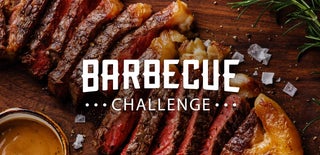Introduction: Low and Slow on a Kettle BBQ (the Fuse Method)
The “Fuse” method (affectionately referred to as the “Snake”) is popular with Australian BBQers wanting to cook “Low and Slow”
The Fuse guarantees a stable temperature, it’s easy to setup and can be relied on to cook your food while you are down the pub with your mates!
Step 1: How Does It Work?
The configuration of the briquettes in the Fuse dictates the amount of heat and the length gives the duration of the burn.
The fuse is carefully laid out and lit fuel is placed on one end. The fire progressively burns to the other end at a consistent rate delivering an even stable heat for the duration of the cook.
A properly prepared fuse can give up to 18 hours of "Low and Slow" cooking in a kettle BBQ
Step 2: Setup the Fuse
In this method we carefully lay two briquettes side by side on the charcoal grate around the wall of the kettle. Then, starting from the end of the “Fuse”, carefully place another briquette on top of the two on the bottom, then lean another on that one and continue leaning the top row on the previous briquette all the way round to the start position.
This structure ensures that as the fire burns, the lit briquettes will “fall” towards the unlit ones and not away from them.
At the very start of the Fuse leave 4 briquettes without the top row, this is a kind of launching pad for the lit briquettes to “Mount” the Fuse and start the whole thing burning.
Care taken in the setup will pay off.
Study my picture and you will see the "launching pad" at the start of my fuse on the left hand side. Make sure you place the lit fuel on the start, the angle of the briquettes helps the fire burn correctly.
Place some wood chips, chunks or herbs along the Fuse for a progressive release of smoke flavour as the Fuse burns
Step 3: Lighting the Fuse
Light a half dozen or so briquettes in a chimney and once burning well, carefully place the lit fuel on the “Launching Pad”.
I have set the bottom vents to half as with the ones in the lid. It is only necessary to adjust the vents if you are fighting ambient conditions like wind or extreme cold.
Wind will blow through the vents and feed the fire making the Fuse burn too fast, closing the vents a little can help but the only real answer to wind is to find a protected spot to cook. Opening the vents will let the fuel burn cleaner and with a little more heat, this helps combat extreme cold
Step 4: Getting Up to Temperature
After half an hour the temperature has settled down to 82°C (180°F).
Another half hour later and the fuse has started to light and the temperature is stable at 105°C (220°F).
Three hours later and the temperature is still 105°C (220°F), the fuse will progressively burn, but because there is only six or so briquettes alight at any time the temperature will stay at 105°C (220°F) for many hours, without the need for any maintenance, in fact you don’t even need to be home!
In this picture you can see the fuse after 6 hours of burning at constant temperature
Step 5: More Ideas for Using the Fuse
Increasing the amount of fuel in the Fuse will increase the temperature; one briquette will add roughly 25°C (50°F).
If for example I use a base of two briquettes in base of the fuse, two on top of that and one more on the top of that (so two more briquettes than in the previous example). The temperature settles in nicely at 152° (305°F) a nice slow roasting temperature.
Once you get used to using your fuel this way, you will be able to modify the setup to provide different results.
You could run a short fuse into a large pile of fuel to start the cook at a low temperature and finish at a high temperature.
You could have the "End" in the centre and run a fuse both directions from that point, lighting both ends will give double the heat.
This is a great method and increases the versatility of your kettle BBQ, give it a try! The butcher has some Pork Ribs just calling your name!

Participated in the
Barbecue Challenge











